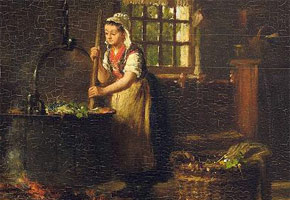

"It was in-between preparation of broth and stews that women began the practice of working in laboratories, developing a series of products that would later be used by doctors and botanists," says scientist (painting by Hendrik Valkenburg)
"It was in-between preparation of broth and stews that women began the practice of working in laboratories, developing a series of products that would later be used by doctors and botanists," says scientist
"It was in-between preparation of broth and stews that women began the practice of working in laboratories, developing a series of products that would later be used by doctors and botanists," says scientist

"It was in-between preparation of broth and stews that women began the practice of working in laboratories, developing a series of products that would later be used by doctors and botanists," says scientist (painting by Hendrik Valkenburg)
By Elton Alisson
Agência FAPESP –The kitchen was women’s gateway into scientific laboratories – the hallmark of modern day science that has become an imminently masculine space, where only a few females have worked hard to stand out in areas that until then had not caught the attention of men.
That is the assessment offered by Ana Maria Alfonso-Goldfarb, professor at Pontifícia Universidade Católica (PUC) in São Paulo, during the latest event in the Cycle of Conferences for the International Year of Chemistry – 2011, held on November 9 in FAPESP’s auditorium. The topic was “Marie Curie’s contribution to science and a look at the role of women scientists.”
According to Goldfarb, through their ability to light and control fire to prepare food – considered a difficult and uniquely feminine activity - women helped to develop a series of products until the mid-Middle Ages. Among them were the first distillers, extracts, perfumes, medicines, pomades and liqueurs.
“The kitchen was a space restricted largely to women. It was somewhere between the preparation of broths and stews that they began the practice of working in laboratories developing a series of products that would later be used by doctors and botanists, which most often appropriated feminine discoveries without give them the due credit,” she said.
According to the researcher, it was during the 16th and 17th century, when the printing press became important and circulation of books grew that “the kitchen medicine,” earned greater importance. Some women that had possessions or social status began to publish books in their names. One of these was Henrietta Maria (1609 -1669) from England, who financed the publishing of the book The Queen’s Closet Opened.
Nevertheless, this phase, which lasted 50 to 60 years, ended precisely at the moment when laboratories emerged, marking the beginning of modern day science. “As a result of this fact, women began to discretely return to the kitchen,” says Goldfarb.
In the 18th century, the major literary salons emerged where women set the tone. However, according to the researcher, they did not have access to scientific societies and the restricted groups of scientists of the day, where science actually happened.
As a result, there are only rare examples of women who did manage to obtain some recognition, albeit superficial, in science of the day. A few of the rare examples are Madame Émilie du Châtelet (1706-1749) and Marie Anne Pierrete Paulze (1758-1836), along with Madame de Lavoisier.
From the 19th to the 20th centuries, the process of feminine scientific education began slowly in Saxonic and Anglo-Saxonic countries, when the first women gained access to colleges. However, the majority of those that managed to graduate ended up returning home frustrated because they couldn’t work.
As an option, some of them directed their careers to areas that were either emerging or experiencing a reformulation, and that demanded fastidious calculation work and observations that spanned months. Among these areas were crystallography, astronomy and radioactivity.
“It was in these areas that there was room for women and in which they were received because they had to be selfless and dedicated to do hard, heavy work that often repelled the masculine sex,” explains Goldfarb.
It was no coincidence that Marie Curie (1967-1934) became the first women to become a Nobel Laureate in Chemistry in 1911 and Physics in 1903, the latter shared with her husband Pierre Curie (1859-1906) and with Antoine Henri Becquerel (1852-1908), precisely for their research on radioactivity.
The daughter of the Polish scientist who relocated to France, Irène Joliot-Curie (1897-1956), became the second woman to win a Nobel Prize in Chemistry in 1934 with her husband Frédéric Joliot-Curie (1900-1958), for the discovery of artificial radioactivity.
And the only other two women that won a Nobel Prize in Chemistry are among 159 laureates with the honor – Egyptian-born and England-based Dorothy Crowfoot Hodgkin (1910-1994) and Israeli scientist Ada Yonath, who both received awards for crystallography.
Republish
The Agency FAPESP licenses news via Creative Commons (CC-BY-NC-ND) so that they can be republished free of charge and in a simple way by other digital or printed vehicles. Agência FAPESP must be credited as the source of the content being republished and the name of the reporter (if any) must be attributed. Using the HMTL button below allows compliance with these rules, detailed in Digital Republishing Policy FAPESP.





